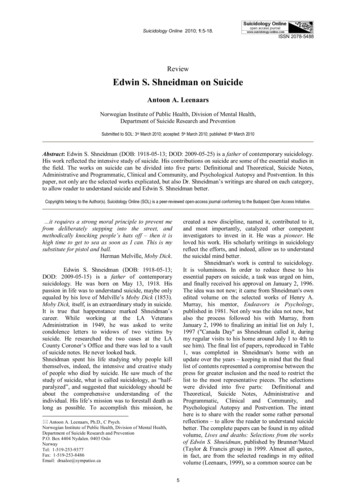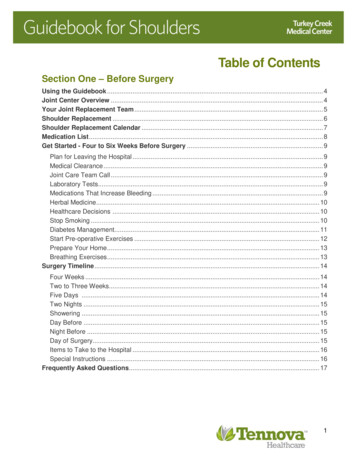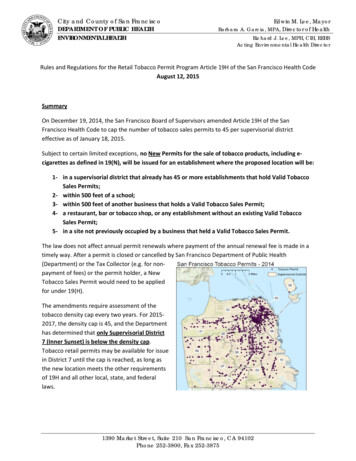
Transcription
Suicidology Online 2010; 1:5-18.ISSN 2078-5488ReviewEdwin S. Shneidman on SuicideAntoon A. LeenaarsNorwegian Institute of Public Health, Division of Mental Health,Department of Suicide Research and PreventionSubmitted to SOL: 3rd March 2010; accepted: 5th March 2010; published: 8th March 2010Abstract: Edwin S. Shneidman (DOB: 1918-05-13; DOD: 2009-05-25) is a father of contemporary suicidology.His work reflected the intensive study of suicide. His contributions on suicide are some of the essential studies inthe field. The works on suicide can be divided into five parts: Definitional and Theoretical, Suicide Notes,Administrative and Programmatic, Clinical and Community, and Psychological Autopsy and Postvention. In thispaper, not only are the selected works explicated, but also Dr. Shneidman’s writings are shared on each category,to allow reader to understand suicide and Edwin S. Shneidman better.Copyrights belong to the Author(s). Suicidology Online (SOL) is a peer-reviewed open-access journal conforming to the Budapest Open Access Initiative.it requires a strong moral principle to prevent mefrom deliberately stepping into the street, andmethodically knocking people’s hats off – then it ishigh time to get to sea as soon as I can. This is mysubstitute for pistol and ball.Herman Melville, Moby Dick.created a new discipline, named it, contributed to it,and most importantly, catalyzed other competentinvestigators to invest in it. He was a pioneer. Heloved his work. His scholarly writings in suicidologyreflect the efforts, and indeed, allow us to understandthe suicidal mind better.Shneidman's work is central to suicidology.It is voluminous. In order to reduce these to hisessential papers on suicide, a task was urged on him,and finally received his approval on January 2, 1996.The idea was not new; it came from Shneidman's ownedited volume on the selected works of Henry A.Murray, his mentor, Endeavors in Psychology,published in 1981. Not only was the idea not new, butalso the process followed his with Murray, fromJanuary 2, 1996 to finalizing an initial list on July 1,1997 ("Canada Day" as Shneidman called it, duringmy regular visits to his home around July 1 to 4th tosee him). The final list of papers, reproduced in Table1, was completed in Shneidman's home with anupdate over the years – keeping in mind that the finallist of contents represented a compromise between thepress for greater inclusion and the need to restrict thelist to the most representative pieces. The selectionswere divided into five parts: Definitional andTheoretical, Suicide Notes, Administrative andProgrammatic, Clinical and Community, andPsychological Autopsy and Postvention. The intenthere is to share with the reader some rather personalreflections – to allow the reader to understand suicidebetter. The complete papers can be found in my editedvolume, Lives and deaths: Selections from the worksof Edwin S. Shneidman, published by Brunner/Mazel(Taylor & Francis group) in 1999. Almost all quotes,in fact, are from the selected readings in my editedvolume (Leenaars, 1999), so a common source can be*Edwin S. Shneidman (DOB: 1918-05-13;DOD: 2009-05-15) is a father of contemporarysuicidology. He was born on May 13, 1918. Hispassion in life was to understand suicide, maybe onlyequaled by his love of Melville’s Moby Dick (1853).Moby Dick, itself, is an extraordinary study in suicide.It is true that happenstance marked Shneidman’scareer. While working at the LA VeteransAdministration in 1949, he was asked to writecondolence letters to widows of two victims bysuicide. He researched the two cases at the LACounty Coroner’s Office and there was led to a vaultof suicide notes. He never looked back.Shneidman spent his life studying why people killthemselves, indeed, the intensive and creative studyof people who died by suicide. He saw much of thestudy of suicide, what is called suicidology, as “halfparalyzed”, and suggested that suicidology should beabout the comprehensive understanding of theindividual. His life’s mission was to forestall death aslong as possible. To accomplish this mission, he Antoon A. Leenaars, Ph.D., C Psych.Norwegian Institute of Public Health, Division of Mental Health,Department of Suicide Research and PreventionP.O. Box 4404 Nydalen. 0403 OsloNorwayTel: 1-519-253-9377Fax: 1-519-253-8486Email: draalee@sympatico.ca*5
Suicidology Online 2010; 1:5-18.ISSN 2078-5488Table 1. Selections from the works on suicide of Edwin S. Shneidman.Definitional and Theoretical(1971). “Suicide” and “suicidology”: A brief etymological note. Suicide and Life-Threatening Behavior, 1, 260-264.(1985). A formal definition, with explication (pp. 202–213). Definition of suicide. New York: Wiley.(1998). “Suicide” in the Encyclopedia Britannica, 1777-1997. Archives of Suicide Research, 4, 189-199.(1973). Suicide (pp. 383-385). Encyclopedia Britannica (Vol. 21). Chicago: William Benton.(1971). Perturbation and lethality as precursors of suicide in a gifted group. Life-Threatening Behavior, 1, 23-45.(1992). A conspectus for conceptualizing the suicidal scenario (pp. 50-65). In R. Maris et al. (Eds.) Assessment and prediction of suicide. New York: Guilford Press.(1993). Suicide as psychache. Journal of Nervous and Mental Disease, 181, 147-149.Suicide Notes(1969). Some characteristics of genuine versus simulated suicide notes (pp. 527-535). In P. J. Stone et al. (Eds.) The general inquirer: A computer approach to contentanalysis. Cambridge: MIT Press. (with D. N. Ogilvie and P. J. Stone)(1973). Suicide notes reconsidered. Psychiatry, 36, 379-395.(1980). Self-destruction: Suicide notes and tragic lives (pp. 41-76). Voices of death. New York: Harper and Row.(1995). Letters of enforced death versus suicide notes. Journal of Psychology and Judaism, 19, 153-160.Administrative and Programmatic(1965). The Los Angeles suicide prevention center: A demonstration of public health feasibilities. American Journal of Public Health, 51, 21-26. (with N. Farberow)(1967). The NIMH center for studies of suicide prevention. Bulletin of Suicidology, 1, 2-7.(1988). Some reflections of a founder. Suicide and Life-Threatening Behavior, 18, 1-12.Clinical and Community(1967). How to prevent suicide. Public affairs pamphlet No. 406. New York: Public Affairs Pamphlets. (with P. Mandelkorn)(1994). Clues to suicide reconsidered. Suicide and Life-Threatening Behavior, 24, 395-397.(1980). Psychotherapy with suicidal patients (pp. 305-313). In T. B. Karasu & L. Bellak (Eds.) Specialized techniques in individual psychotherapy. New York:Brunner/Mazel.(1984). Aphorisms of suicide and some implications for psychotherapy. American Journal of Psychotherapy, 38, 319-328.(1992). Letter to editor, Rational suicide and psychiatric disorders. New England Journal of Medicine, 326(13), 889.Psychological Autopsy and Postvention(1977). The psychological autopsy (pp. 42-57). In L. I. Gottschalk et al. (Eds.) Guide to the investigation and reporting of drug abuse deaths. Washington, DC: USDHEW,U.S. Government Printing Office.(1994). Comment: The psychological autopsy. American Psychologist, 39(1), 75-76.(1993). An example of an equivocal death clarified in a court of law (pp. 211-246). Suicide as psychache. Northvale: Jason Aronson Inc.(1975). Postvention: The care of the bereaved (pp. 245-256). In R. O. Pasnau (Ed.) Consultation in liaison psychiatry. New York: Grune and Stratton.6
Suicidology Online 2010; 1:5-18.ISSN 2078-5488found. However, the rights are from the original text,and belong to Edwin Shneidman. David Shneidman,his son, granted permission to quote from s, March 2, 2010).From Shneidman’s perspective:The view of the psychological factors in suicide, thekey element in every case is psychological pain:psychache. All affective states (such as rage, hostility,depression, shame, guilt, affectlessness, hopelessness,etc.) are relevant to suicide only as they related tounbearable psychological pain. If, for example,feeling guilty or depressed or having a bad conscienceor an overwhelming unconscious rage makes onesuicidal, it does so only because it is painful. Nopsychache, no suicide. (Leenaars, 1999, p. 243).SuicideIn his reflections, Edwin Shneidman doesnot know whether suicide was looking for him or hewas looking for suicide. However, on a day in 1949,when he discovered 100’s of “genuine suicide notes”,he was restless and looking for some niche inpsychology. Here is verbatim what Shneidman (1991)wrote:The fulcrum moment of my suicidological life wasnot when I came across several hundred suicide notesin a coroner’s vault while on an errand for thedirector of the VA hospital, but rather a few minuteslater, in the instant when I had a glimmering that theirvast potential value could be immeasurably increasedif I did not read them, but rather compared them, in acontrolled blind experiment, with simulated suicidenotes that might be elicited from matched nonsuicidalpersons. My old conceptual friend, John Stuart Mill’sMethod of Difference, came to my side and handedme my career. (Leenaars, 1999, p. 247).In religion, we talk about Epiphanies and Epiphanymoments. That the notes were “genuine” was anepiphanic moment for Shneidman. He had anautonomic reaction with the feeling, withoutverbalizing, that it was important to say “genuine”suicide note. Within a couple of months of saying“genuine” and then “simulated” and then elicitingnotes, and then calling Norman Farberow, he wasbeginning a career – and a discipline. He said, ‘ohboy, suicide notes, the golden road to suicide,’ andsuicidology began.All his work on suicide is explication of thatidea. Shneidman is first and foremost a suicidologist.We will next examine his works on suicide,subdivided as shown in Table 1. We will illustrateeach of these endeavors, with comprehensive quotesfrom his writings.Conceptual and TheoreticalFor Shneidman, you begin with definitionand theory, and if it is pain, then you talk aboutperturbation and lethality. Shneidman would begin hisscience with the Oxford English Dictionary (OED), toprovide the basis for a definition of suicide. We learnthat the word suicide is a fairly recent one, and did notexist until the 18th century. Shneidman (1971a) writes:The OED indicates that the earliest use of “suicide”was essentially a Latinizing of the concept of selfkiller or self-destroyer. The term was apparently notused until 1651. A. Alvarez claims that he found theword a little earlier in Sir Thomas Browne’s ReligioMedici, written in 1635, published in 1642. By themid-eighteenth century, the word seems to have beengenerally known to literary men in England. In thenineteenth century, French writers – Boismont,Durkheim, Qutelelt – did much with the word. Today,“suicide” is everyone’s word, the almost internationallabeling for – as a recent definition has it – “thehuman act of self-inflicted, self-intentional cessation”(International Encyclopedia of the Social Sciences,1968, vol. 15, pp. 385-89).Disregarding all of biology and genetics,Professor Shneidman stated that suicide is essentiallypsychological pain. It is not entirely so, and maybenot centrally so, but that is what, he stated, we caninvestigate and explicate. Shneidman’s maincontribution has been the explication of the pain. Hewrites:As I near the end of my career in suicidology, I thinkI can now say what has been on my mind in as few asfive words: Suicide is caused by psychache (sik-ak;two syllables). Psychache refers to the hurt, anguish,soreness, aching, psychological pain in the psyche,the mind. It is intrinsically psychological – the pain ofexcessively felt shame, or guilt, or humiliation, orwhatever. When it occurs, its reality is introspectivelyundeniable. Suicide occurs when the psychache isdeemed by that person to be unbearable. This meansthat suicide also has to do with different individualthresholds for enduring psychological pain(Shneidman, 1985, 1992a). (Leenaars, 1999, p. 239).Shneidman’s unquestionable best book onsuicide is Definition of Suicide (1985) in which heasserts a psychologically oriented definition of suicideand then explicates (except for prepositions andconjunctions) every single word of it. I highlyrecommend it to any aspiring and veteransuicidologist. From an epistemological perspective, itis worth a read:To use an arboreal image: The psychologicalcomponent in suicide is the “trunk” of it. Anindividual’s method of suicide, the contents of thesuicidal note, the calculated effects on the survivors,and so on, are the branching limbs, the flawed fruitand the camouflaging leaves. But the psychological7
Suicidology Online 2010; 1:5-18.ISSN 2078-5488component, the problem-solving choice – the bestsolution to the perceived problem – is the main trunk.We may now proceed to my proposed definition ofsuicide.Currently in the Western world, suicide is a consciousact of self-induced annihilation, best understood as amultidimensional malaise in a needful individual whodefines an issue for which the suicide is perceived asthe best solution. (Leenaars, 1999, p. 155).that the goal of action relates to death (rather thanself-injury or self-mutilation); and that it focuses onthe concept of the cessation of the individual’sconscious, introspective life. The word “suicide”would seem to be clear enough, although such phrasesas “self-inflicted” (in the incident in which Saul askedanother soldier to kill him) and “self-intentioned”(when Seneca was ordered by Nero to kill himself)add to the complications of finding a clear-cutdefinition of suicide. (Leenaars, 1999, pp. 176-177).Shneidman goes further and attempts anexplication of this definition in all his subsequentwork, by clarifying the meaning, and makingmeaning of suicide.The most important book in Shneidman’slife is the Encyclopaedia Britannica (EB). InShneidman (1998) “’Suicide’ in the EncyclopaediaBritannica, 1777-1997”, the entries on “Suicide”, intwenty successive printings (involving 15 e
In R. O. Pasnau (Ed.) Consultation in liaison psychiatry. New York: Grune and Stratton. Suicidology Online 2010; 1:5-18. ISSN 2078-5488 7 found. However, the rights are from the original text, and belong to Edwin Shneidman. David Shneidman, his son, granted permission to quote from the selections (David Shneidman, personal communications, March 2, 2010). Suicide In his reflections, Edwin .











